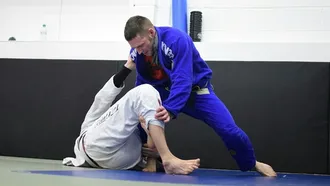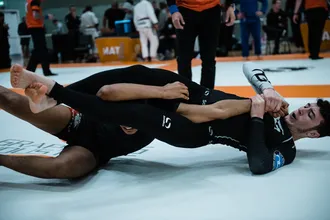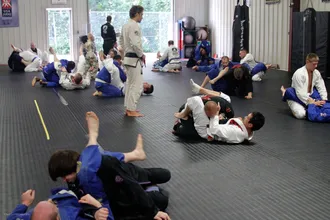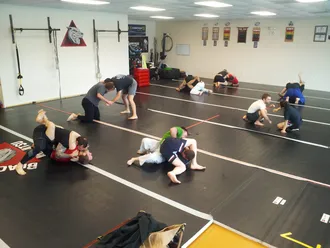
Brazilian Jiu Jitsu (BJJ) is a martial art that has captured the attention of many around the world, thanks to its unique approach to combat. Central to this approach is the concept of the "guard," a position that is as complex as it is effective.
In this expanded exploration, we'll delve even deeper into the guard, its purpose, variations, the art of guard passing, and how it's applied in both Gi and NoGi contexts. Whether you're a beginner or a seasoned practitioner, understanding the guard is key to your development in BJJ.
- The Guard in BJJ: A Position of Power and Possibility
- The Purpose of the Guard in BJJ
- The Art of Guard Passing in BJJ
- Training Tips for Improving Your Guard Game
- Guard in BJJ Competitions: A Tactical Battlefield
- Pulling Guard in BJJ: A Strategic Choice
- The Psychological Aspect of Guard Play
- Guard Retention and Recovery
- Integrating Guard Play into Your Overall BJJ Strategy
- Conclusion: The Guard as a Cornerstone of BJJ Mastery
The Guard in BJJ: A Position of Power and Possibility
The guard is more than a mere position; it's a statement of strategy and philosophy in BJJ. When in the guard, the practitioner on the bottom, known as the "guard player," uses their legs to control an opponent, who is standing or kneeling.
This position flips the traditional notion of a fight, where being on your back is seen as a disadvantage. In BJJ, the guard allows a smaller, weaker individual to effectively defend against and even attack a larger opponent using leverage, technique, and timing.
The Purpose of the Guard in BJJ
The guard serves multiple purposes in BJJ. Primarily, it's a defensive fortress, it's also a launching pad setting up attacks, and a test of patience and skill.
From the guard, a practitioner can protect themselves, manage the distance, control the opponent's movements, and set up a variety of sweeps and submissions. It's a position that allows for control, with the ultimate goal of neutralizing an opponent's advantages in strength or size - getting from a defensive cycle to an offensive cycle
Gi vs. NoGi Guard: A Detailed Comparison
The guard's dynamics vary significantly between Gi and NoGi BJJ:
- Gi Guard: The Gi, with its jacket, pants, and belt, offers numerous grip options. These grips enable the guard player to control the opponent's posture, set up submissions, and execute sweeps. The Gi adds a layer of technical complexity and allows for more methodical play. It slows down the game and adds a layer of technical complexity
- NoGi Guard: Without the grips provided by the Gi, NoGi BJJ demands a different approach. Here, the guard relies more on clinching techniques, using underhooks, overhooks, and body locks. The pace is generally faster, and the guard player must be adept at adjusting to the dynamic nature of NoGi grappling.
Exploring Guard Variations in BJJ
- Closed Guard: The closed guard is a foundational position where the guard player wraps their legs around the opponent's torso, locking their feet. It's a secure position that is excellent for beginners to learn the fundamentals of guard play.
- Open Guard: This is a more dynamic version of the guard, where the legs are not locked around the opponent. It includes variations like the spider guard, De La Riva, and X-guard, each offering different control and attack options.
- Half Guard: In the half guard, the bottom player controls one of the opponent's legs between their own. This position is versatile, allowing for various sweeps and transitions to other guards.
- Butterfly Guard: Utilizing both legs in a hooking motion against the inner thighs of the opponent, the butterfly guard is excellent for sweeps and maintaining distance.
- Spider Guard: A classic Gi guard, the spider guard allows the practitioner to control the opponent's arms using their feet, creating distance and setting up attacks.
- De La Riva Guard: Named after the legendary Ricardo De La Riva, this guard involves wrapping one leg around the opponent's leg and controlling their ankle or hip, ideal for sweeps and back takes.
The Art of Guard Passing in BJJ
Guard passing is the counter-strategy to the guard. It involves breaking the guard player's leg configuration and moving into a more dominant position, like side control or mount.
Guard passing is a skill that requires patience, technique, and timing. A successful pass often hinges on the ability to control the guard player's hips, break their grips, and navigate through their defenses without getting caught in submissions or sweeps.
Training Tips for Improving Your Guard Game
To enhance your guard skills, consider the following:
- Develop Hip Mobility and Flexibility: Efficient movement and the ability to create angles are crucial in guard play. Drills and exercises that improve hip mobility can significantly enhance your guard.
- Practice Grip Fighting: In Gi BJJ, winning the grip battle is often the first step to controlling the guard. In NoGi, focus on securing underhooks and overhooks.
- Balance Defense and Offense: A good guard player is always ready to defend against passes and attacks while looking for opportunities to sweep or submit.
- Drill Transitions and Combinations: Fluidity between different guard styles can make your game unpredictable and challenging for your opponents.
- Study and Analyze Matches: Watching high-level BJJ practitioners and analyzing their guard strategies can provide valuable insights.
Guard in BJJ Competitions: A Tactical Battlefield
In BJJ tournaments, the guard is where many battles are won or lost. Points are awarded for successful guard passes, and a strong guard can be a formidable weapon. Competitors must be adept at both playing and passing the guard to succeed at the highest levels.
Competitors must skillfully navigate both offensive and defensive aspects of the guard, showcasing proficiency in playing and passing, to secure success at the pinnacle of competition. It's a dynamic dance of skill and strategy, where the mastery of the guard becomes a defining factor in achieving triumph.
Pulling Guard in BJJ: A Strategic Choice
Pulling guard is a strategic move used by practitioners who are confident in their ground game. It involves deliberately going to the ground, typically by gripping the opponent and using a combination of movement and momentum to sit or fall back into their favored guard position.
This tactic is prevalent in both gi and no-gi scenarios, although the techniques and grips differ due to the presence or absence of the gi.
Gi vs. No-Gi Guard Pulling
In Gi BJJ, practitioners have the advantage of using the gi for grips, making it easier to control the opponent while pulling guard. They can grab the sleeves, lapels, or pants, which provides numerous options for securing the guard.
In No-Gi BJJ, however, the lack of grips requires a different approach. The No-Gi guard pull is generally more dynamic and requires a greater emphasis on speed and timing due to the lack of fabric to hold onto. Competitors often rely on 2-on-1 control to effectively pull guard.
Pulling guard in No-Gi can be penalized in some rule sets, an initial grip must be established before sitting down. In other rulesets, such as King of the Beach, you will be a penalized for pulling guard regardless of how you do it.
The Psychological Aspect of Guard Play
Playing the guard effectively is not just a physical challenge; it's a mental and psychological game. Patience is key. A guard must resist the urge to rush or force actions, understanding that hasty decisions often lead to mistakes.
This patience is closely tied to the ability to remain calm under pressure. In the heat of the moment, when the opponent is bearing down, a calm mind is essential for clear decision-making. It's this clarity that allows the guard to observe and exploit the opponent's weaknesses.
Guard Retention and Recovery
An essential aspect of playing guard is the ability to retain it against an opponent's passing attempts. This involves understanding angles, using frames (creating barriers with arms and legs), and constantly adjusting to the opponent's movements.
When the guard is breached, practitioners must also have effective recovery techniques to reestablish the guard and prevent the opponent from advancing to a more dominant position.
Integrating Guard Play into Your Overall BJJ Strategy
A well-rounded BJJ practitioner integrates their guard game seamlessly with other aspects of their grappling.
This means being able to transition from guard to top positions, integrating guard sweeps into submission chains, and understanding how to use the guard in both offensive and defensive strategies.
Conclusion: The Guard as a Cornerstone of BJJ Mastery
The guard in BJJ is a deep and rich aspect of the art, offering a blend of technical, physical, and psychological challenges.
Whether training in Gi or No-Gi, developing a strong guard game is essential for any practitioner.
Remember, the journey in BJJ is continuous. Keep training, exploring, and enjoying the art, and let the guard be a cornerstone of your grappling journey.










